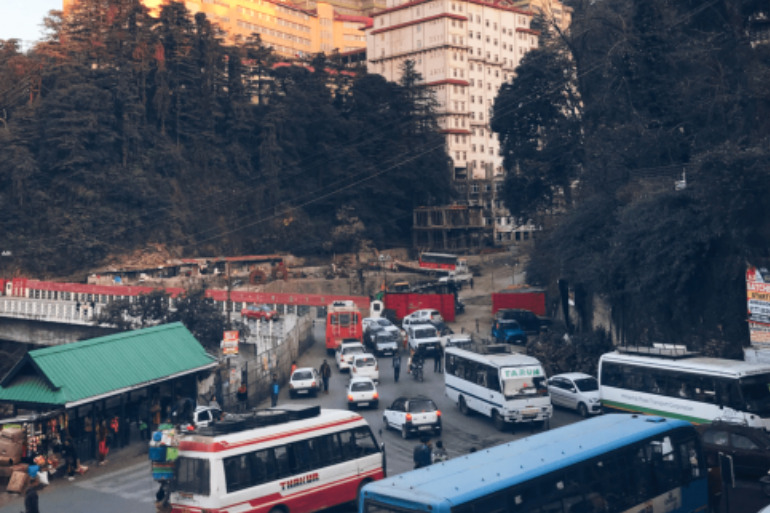Over the years, a massive increase in the purchase of cars has further increased vulnerability, and the system is becoming overwhelmed and completely unsustainable.
“Tango Charlie 7, allow the passage of the cars and do not stop them,” this was the message on the wireless set of a traffic police cop stationed at Khalini Chowk at 8 pm.
When asked, the traffic official said that the voice on the wireless set was of Sanjeev Gandhi, the superintendent of police, Shimla. He further said he could monitor the city’s traffic from his home as he had screens at his residence.
While it is amusing to hear SP’s voice on a traffic signal, one can also see that the system is not the best. This is an intermediary solution at best.
What if Gandhi is gone? Will his successor also be able to work with the same competence and diligence? Soon, if a significant disruption is not done, the mobility system in Shimla will be completely overwhelmed. And then, even if an entire battalion of police is deployed on the roads, the situation will remain the same. Why?
Let us try to understand the reality.
May and June are tourist months, and it is estimated that more than 55,000 vehicles enter the town during the weekend. The comprehensive mobility plan adopted in the city during the term when the author was serving the city as a deputy mayor had forewarned of a complete failure if the motorised transport in the town is not regulated. Emphasis is not laid on the culturally adapted pedestrian and public transport forms of public mobility.
During the survey, while preparing the CMP, it was estimated a very high volume of Passenger Car Units (PCU). In a regularly conducted survey for 16 hours a day, the PCU varied from 4,000 to 45,000 at bottlenecks like the Victory Tunnel in Shimla. Not just that another important feature that was registered in the CMP is that the difference between PCU and total passenger flow is not too large. In simple terms, it means that those travelling by individual cars and driving as a single passenger is a large number. Though a high volume of people, roughly 43 per cent were pedestrians, and the rest used motorised transport as their commute mode in the town.
Over the years, a massive increase in the purchase of cars has further increased vulnerability, and the system is becoming overwhelmed and completely unsustainable. The answer of the planning authorities has been short termed, myopic, and in tune with the market principles.
The widening of roads has given spaces for parking cars instead of better mobility; likewise, creating more parking spaces has induced people to buy more cars; with the push from the elite sections in the town, two major roads that were sealed for motorised transport were also made open with the hope that this would ease traffic snarls. However, the result is that the traffic jams have increased and the total time per trip has increased by more than an hour. This is completely unsustainable.
Major Disruption Needed
A mountain town requires both a land use plan and a mobility plan adapted to the needs of the hill people. Emphasis must be made on non-motorised transport, ensuring pollution-free and sustainable mobility. For that, a major disruption is required, and that was also the broad direction in which the CMP was written and adopted in the municipal corporation.
A large investment is required in the public transport system. There must be a large investment in infrastructure for such multimodal public transport. This includes increasing the fleet of electric buses with modern technology. Likewise, the investment must be made in constructing ropeways as a mode of transport within the town. Vertical mobility is another feature that is required in the hills. This means more elevators, escalators, and such forms of transport models.
Strong pedestrianisation: Shimla is known as a town of pedestrians. This idea must be reinforced, and a competitive design should be created to make such pathways. Instead of wasting money by constructing very narrow steel frame pedestrian pathways, a competitive design must be adapted to the mountain features. Besides, these paths must be secure and safe for people, particularly women, to walk even during the late hours of the day.
Bicycle Tracks: Not all know that Shimla is the only town amongst a few others to have a license for a bicycle. This was part of the British period mobility plan. The bicycle was used even in earlier periods. This must be strengthened, and bicycle tracks must be built. A shared bicycle scheme must be started in innovative ways. Bicycle stands must be installed to ensure safe parking. Only a few opt for bicycles as a mode of transport owing to the mountain’s steepness. A comprehensive plan for bicycle mobility must be discussed, along with providing shower facilities in some offices and public places for bicycle riders.
Strong coercion methods: Strong coercion methods should also be adopted. These include levying green fees from those using cars and other motorised transport. Likewise, a peak hour cess must be levied on those who use their cars with a single passenger. This should not be allowed.
Single-driven cars must be dissuaded, and the pooling of the cars should be allowed. Even formulae like odd-even cars can be tried in Shimla town, and lessons learned should be incorporated into the larger plan.
Schools’ timings must be adjusted so that there is no single-hour rush. Also, private cars ferrying individual students must be heavily charged, ensuring that either they pool or use public transport as a mode of transport.
The current form of seeking a solution by constructing a flyover over Victory Tunnel will not solve problems; rather, it will further accentuate the same.
Shimla, a town that offers so much, should not become another sad story like Bangalore or Delhi, where mobility is guided by more capital-intensive solutions and not by the sheer desire to work with the basic principle: “Is it mobility of the people that we are taking care of or mobility of the cars”?
The mobility of people and the mobility of cars are not synonymous!
Former deputy mayor Shimla.
National convenor, NCU, National Coalition for Inclusive & Sustainable Urbanisation.




